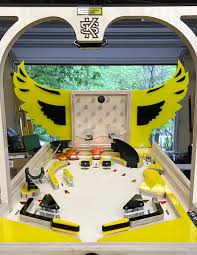Source: mdjonline.com
Where is the fun in a pinball machine that can play itself? How about pancakes that can cook themselves?
For students in Kennesaw State University’s Department of Mechatronic Engineering, the intrigue is less about the act and more about what goes on behind the scenes to make it possible. From a fully automated pinball machine to a pancake vending system that can cook without human intervention, several student teams recently took full advantage of their senior capstone coursework to prove that engineering can be creative while practical.
Since its inception, the mechatronics engineering department has emphasized building physical prototypes for its senior capstone coursework, allowing students to pitch projects of their own or select one from a pool of industry sponsors, said Kevin McFall, associate professor of mechatronics engineering and assistant dean for research in the Southern Polytechnic College of Engineering and Engineering Technology. However, what makes the mechatronics capstone process distinct from others across the college is that the students can select the minimum success criteria for their project. This means each team creates their own criteria for judgement, reports it to their professors and is solely judged on those self-made parameters.
In order to pass, McFall said students must demonstrate their ability to build something that achieves the three fundamental principles of mechatronics engineering: sense, think and act. All projects must have a mechanical design, a way to acquire data from a series of sensors, some sort of programmable device and a way to control an actual moving part.
Some students, like student Tyler Gragg, embrace the freedom to generate a unique project. A self-declared pinball machine aficionado, Gragg has always felt the desire to build a machine of his own. When he pitched the idea to teammates Kevin Kamperman, Cody Meier and Omar Salazar Lima, they conceived a design that would allow the pinball machine to play itself using a video camera to detect when the ball enters the “flipper zone,” which then triggers the flippers to move automatically and keep the ball in play.
Following the spread of the coronavirus, the team worked with staff members in the Department of Architecture to fabricate final pieces while they remained off campus. Since most teams completed most of their design work and built their components in advance, they were able to the see their projects to completion amidst the changes caused by COVID-19.
For Tim Ervin, inspiration for his senior capstone project came in the form of a YouTube video in which a team of engineers cooked a four-foot pancake using a robotic arm. Rather than make an impractical and gargantuan pancake, teammate Jay Strickland suggested that they make something that can cook several smaller pancakes. Along with fellow former students Brittney Smith and Ryan McHale, they built what they call a pancake vending machine, which can accept digital payment in exchange for one perfectly cooked pancake.
The self-contained machine is able to dispense the correct amount of batter onto a griddle, and then, with a spatula attached to a robotic arm, flip the pancake for an even cook on each side. The entire process can be done in just five minutes.

